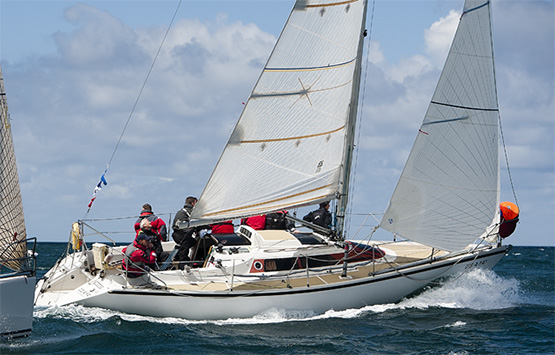Displaying items by tag: Daniel O’Connell
It was in 1828 – 178 years ago - that a regatta sailed at Kilrush led to the formation the Royal Western Yacht Club of Ireland writes W M Nixon. Ten years later, the new club was thriving with a fleet of 18 substantial yachts based in Kilrush Creek. While the members sailed and cruised on the Irish coast southeast around to Cork Harbour and north to Galway, their focus was mainly on northwest Kerry, with the club maintaining a “Station” at Tralee
One of the families most prominent in the RWTC of I’s establishment were the O’Connells of Tralee, Cahirsiveen and Derrynane, the leading role being taken by Maurice “Hunting Cap” O’Connell. He was the prime mover in creating the 1828 gathering at Kilrush, while his nephew Daniel O’Connell of Derrynane, The Liberator, was also an active member.
The depredations of the Great Famine of the 1840s wiped out virtually all yachting activity on the west coast, but a few yachts of the old RWYCoI were moved in very reduced circumstance to Ireland’s east coast. By this stage Daniel O’Connell’s political work in combatting the Famine was taking up much of his energy, but when on the 4th July 1846 a meeting was held in a Dublin hotel to re-establish Dublin Bay’s Royal Irish YC of 1831, Daniel O’Connell was one of those present to ensure that the club in its reborn form had moved on to properly accommodate the most ancient Irish aristocracy, together with the rising Dublin Catholic middle class, and other religions whose adherents were hampered in their sailing by not being of the Established Church, people like Quakers and Presbyterians.

The McGibney family’s Dehler Dis-a-Ray from Tarbert in the Shannon Estuary is expected to be one of the favourites
This re-birth of the RIYC was a remarkable declaration of faith and national optimism in a very dark period, and the fact that its iconic new waterfront clubhouse had been built beside Dun Laoghaire harbour by 1851 was symbolic of the slow emergenece from the horrors of the famine.
Yet despite this successful new development, some members of the old Royal Western Yacht Club of Ireland kept the faith with their ancient if now decidedly threadbare and homeless club. Although some reports would assert that the RWYC of I was wound up in Cobh, of all places, in the 1870s, in Kilrush the Glynn family continued to maintain that the RWYC of I had never died, and they continually added to their already significant collection of old club memorabilia, minute books and other documentation.
So when a near-miracle occurred with Shannon Development bringing Kilrush Marina into being in 1991, securely sheltered within its tide-retaining breakwater and accessed via a sea-lock, a club of some sort was needed by the sailing cruisers using the welcome new facility. While they initially called it the Western Yacht Club, it soon became the Royal Western of Ireland, complete with the authentic colours of 1828 as cherished by the Glynns, and from tomorrow (Wednsday June 29th) through to Saturday July 2nd, the RWYC of I is hosting the WIORA West of Ireland Championship, with a fleet of 30 boats mostly from the Atlantic seaboard competing.
The visitors will find that the host club can provide an unusual link with its distant past, as current Commodore Adrian O’Connell is directly descended from people related to the founders. A distant but direct ancestor was a second cousin of Daniel O’Connell, and that ancestor’s sister Mary O’Connell became Mrs Daniel O’Connell.
Families are very much the thing in Shannon Estuary sailing, as the renowned McGibney family of Tarbert, whose home club is at Foynes, will have three boats racing. Irish Cruiser Racing Association Commodore Simon McGibney tells us that the McGibney campaign will be spread across all three, with the family’s well-known Dehler 0ptima 101 Dis-a-ray being supported by a J/24 and a GK24.

Barry Heskin & partners with the Dubois 34 Nowwhat (GBSC) were runners-up in Division 1 IRC in the 2015 WIORA Championship
WIORA will be celebrating its 40th Anniversary with this championship, which over the years has been staged as far south as Tralee Bay SC, and as far north as Mayo SC on Clew Bay. Kilrush is looking well for the brithday celebrations, as the harbour complex has been bought over and re-furbished by noted marine-specialising civil engineering firm L & M Keating, with Kim Roberts as Marina Manager. L & M Keating is headquartered in nearby Kilmihil, but is active on projects throughout Ireland, and the firm is supporting the WIORA Championship with Kilrush Credit Union as main sponsors. Racing starts tomorrow, meanwhile here’s the results of last year’s breezy championship in Galway Bay:
WIORA West of Ireland Championship 2015
Division 1 IRC
1 Joie De Vie, Silvie Blazkova/Cahill G, (J/109 Galway Bay Sailing Club)
2 NowWhat, Barry Heskin (Galway Bay Sailing Club)
3 Xena , Ian Gaughan, (Mayo Sailing Club)
Division 2 IRC
1 Tribal, Liam Burke, (Corby 25 Galway Bay Sailing Club)
2 Dis-a-Ray, Raymond McGibney, (Foynes YC)
3 Treyona, Finbar O'Connell (Tralee Bay SC)
Division 3 IRC
1 Jaguar, Gary Fort, (Tralee Bay SC)
2 Battle, JP Buckley, (FoynesYC)
3 Running Tide, Michael Mulloy (MayoSC)
White Sails
1 Jabiru, Pat O'Shea, Jim Lawlor (Royal Western YC)
2 Poitin, Bev Lowes ( Foynes YC)
3 Zephyr, Kieran Ruane, (GarrykennedySC)





























































